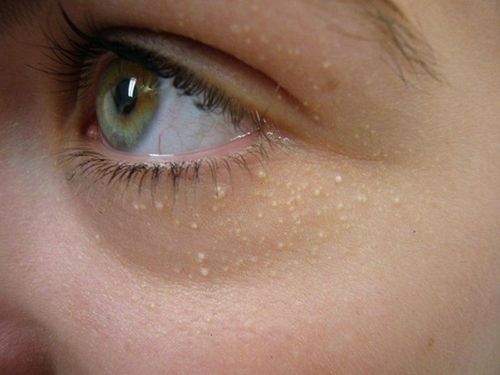This is an automatically translated article.
Squamous cell cancer is the second most common type of skin cancer. It is commonly found on areas of the body that have been damaged by UV rays from the sun or tanning beds. Areas of skin that are regularly exposed to the sun include the head, neck, chest, upper back, ears, lips, arms, legs, and hands.1. What is squamous cell cancer?
Squamous cell cancer (SCC), also known as squamous cell carcinoma, is a type of skin cancer that starts in the squamous cells.Squamous cells are thin, flat cells that are a component of the epidermis, or outermost layer of skin. Other parts of the body that also have squamous cells and can become cancerous include the lungs, mucous membranes, and urinary tract.
According to the Skin Cancer Foundation, cutaneous squamous cell cancer (SCC of the skin) is the second most common form of skin cancer. About 700,000 people in the US are diagnosed with this type of skin cancer each year.
People with squamous cell cancer often develop scaly, red patches, open sores, or warts on their skin. These abnormal tumors can develop anywhere, but they are most commonly found in areas most exposed to ultraviolet (UV) radiation, from sunlight or from beds or beds. sunbathing lamp. Areas of skin that are regularly exposed to the sun include the head, neck, chest, upper back, ears, lips, arms, legs, and hands.
This cancer is not usually life-threatening, but it can become dangerous if left untreated. If left untreated, squamous cell tumors can grow in size and spread to other parts of the body, causing serious complications.
Skin squamous cell cancer is a fairly slow-growing type of skin cancer. Unlike other types of skin cancer, it can spread to nearby tissues, bones, and lymph nodes, where it can become difficult to treat. When detected early, it is easy to treat.
2. Different types of skin cancer
Your skin has many layers and the outer protective layer is the epidermis. The epidermis is made up of squamous cells, basal cells, and melanocytes. These cells are constantly shedding to make room for new skin cells.However, when certain genetic changes occur in the DNA of any of these cells, skin cancer can occur. The main types of skin cancer are squamous cell carcinoma, basal cell carcinoma, and malignant melanoma.
2. 1. Squamous cell cancer Squamous cells are the cells closest to the surface of the skin and their main function is to line the skin. Squamous cell cancer usually develops on areas of the body that are frequently exposed to UV radiation, such as the face, hands, and ears. Squamous cell cancer can also occur in other areas of the body, such as the lungs and urinary tract.
2. 2. Basal cell cancer Basal cells are located underneath the squamous cells and they are constantly dividing to form new cells. According to the American Cancer Society, basal cell cancer is the most common type of cancer.
Like squamous cell cancer, basal cell cancer develops on areas exposed to UV rays, especially the face and neck. This type of cancer tends to grow slowly and rarely spreads to other parts of the body.
However, if basal cell cancer is left untreated, it can eventually spread to bones and other tissues.
2. 3. Malignant melanoma The melanocytes are located along with the basal cells in the deepest part of the epidermis. Melanin cells produce melanin, the pigment that gives the skin its color. When cancer develops in the melanocytes, it is called malignant melanoma.
Malignant melanoma is less common than squamous cell and basal cell cancers, but it is more likely to grow and spread when left untreated.
3. What are the symptoms of squamous cell cancer?
Squamous cell cancer usually occurs in areas of the skin that are exposed to UV radiation, such as the face, ears, and hands. However, it can also appear in the mouth, in the anal area, and in the genitals.In the early stages, squamous cell cancer usually presents as a scaly and reddish patch of skin. As it progresses, the disease can turn into a bump and continue to grow. The growth of cancer cells can also scab or bleed.
In the mouth, squamous cell carcinoma will appear as a sore in the mouth or a white patch.
You may also notice a new growth on a pre-existing scar, mole or birthmark. Any wound or sore that doesn't heal can be a sign of this disease.
Visit your dermatologist immediately if you notice any unusual symptoms. Early diagnosis and treatment is important to prevent complications. Those symptoms include:
Hard red nodules. Scaly flat sores. New sores appear or emerge on top of old scars or sores. A rough, scaly patch on the lip can develop into an open sore. Red sores or rough patches inside your mouth. A red, raised patch or wart-like sore on or in the anus.

U tế bào vảy là gì là thắc mắc của nhiều người
4. What causes squamous cell cancer?
Skin cancer in general and squamous cell cancer in particular are caused by mutations that occur in the DNA of skin cells. These mutations cause abnormal cells to multiply out of control.UV radiation is the most common cause of DNA mutations that lead to skin cancer. UV rays are found in sunlight as well as in lamps and tanning beds.
Although chronic exposure to UV radiation significantly increases the risk of skin cancer, this type of cancer can also develop in people who don't spend a lot of time in the sun or on a sunbed.
It is people who have a genetic predisposition to skin cancer or they may have a weakened immune system that increases their chances of developing skin cancer. People who have previously received radiation treatment also have a higher risk of skin cancer.
In addition to the above causes, there are also risk factors that increase the likelihood of squamous cell cancer. Those risk factors include:
Fair skin: Anyone, regardless of skin color, can get squamous cell carcinoma of the skin. However, having less pigment (melanin) in your skin reduces protection from more damaging UV radiation. If you have fair skin, blond or red hair and light-colored eyes and you are prone to freckles or sunburn, you are more likely to develop skin cancer, including squamous cell carcinoma, than a person with dark skin. Excessive sun exposure: Exposure to UV rays from the sun increases the risk of squamous cell carcinoma of the skin. Spending a lot of time in the sun, especially if you don't cover your skin with clothing or sunscreen, increases your risk of squamous cell carcinoma of the skin even more. Using tanning beds: People who use tanning beds indoors have a higher risk of developing squamous cell carcinoma of the skin. History of sunburn: Having one or more blistering sunburns as a child or teen increases your risk of developing squamous cell carcinoma of the skin as an adult. Sunburn in adulthood is also a risk factor. Personal history of precancerous skin lesions: Having a precancerous skin lesion, such as actinic keratosis or Bowen's disease, increases the risk of squamous cell carcinoma of the skin. Personal history of skin cancer: If you've had squamous cell carcinoma of the skin once, you're more likely to develop the disease again. Weakened Immune System: People with weakened immune systems have a higher risk of skin cancer. This includes people with leukemia or lymphoma and people who are taking medications that suppress the immune system, such as people who have undergone an organ transplant. Rare genetic disorder: People with xeroderma pigmentosum, which are extremely sensitive to sunlight, have a much higher risk of developing skin cancer. People with a history of exposure to chemicals: Like arsenic.
5. Complications of squamous cell cancer
Untreated squamous cell carcinoma of the skin can destroy nearby healthy tissue, spread to lymph nodes or other organs, and the condition can be fatal, although this is uncommon. variable.The risk of squamous cell carcinoma of the skin causing life-threatening complications may be increased in cases of cancer:
Particularly large or deep The cancer involves mucous membranes such as the lips. The disease occurs in people with weakened immune systems such as people taking anti-rejection drugs after an organ transplant or people with chronic leukemia.
6. How is squamous cell cancer diagnosed?
Your doctor will first do a physical exam and check any abnormal areas for signs of squamous cell cancer. Your doctor will also ask you about your medical history. If squamous cell cancer is suspected, your doctor may decide to do a biopsy to confirm the diagnosis.A biopsy usually involves taking a very small part of the affected skin. The skin sample is then sent to a lab for testing. In some cases, your doctor may need to remove a larger portion of skin or all of the abnormal growth for testing.

Phát hiện sớm ung thư tế bào vảy là chìa khóa để điều trị thành công
7. How is squamous cell cancer treated?
Treatment for squamous cell cancer is based on the following factors:The severity of your cancer. Your age Your overall health The location of the cancer If squamous cell cancer is found early, the condition can often be treated successfully. It will become harder to treat as it has spread. Various methods can be used to treat this condition, including:
Mohs surgery: In Mohs surgery, the doctor uses a scalpel to remove the abnormal skin and some surrounding tissue. Samples are examined immediately by observation under a microscope. If there are any cancer cells in the sample, this treatment is repeated until no cancer cells are found. Special surgery: During surgical surgery, the doctor removes cancer cells as well as a thin layer of healthy skin in the surrounding area. The doctor will then sew up the surgical area. The skin sample will then be sent to a lab to make sure the entire cancerous area has been removed. Electrosurgery: Also known as curettage and ablation, electrosurgery involves scraping the cancerous mass and burning the skin to kill cancer cells. This surgical process is usually done several times to ensure complete treatment and complete removal of the cancer. Cryosurgery: During cryosurgery, your doctor uses liquid nitrogen to freeze and destroy cancerous tissue. Like electrosurgery, this procedure needs to be repeated several times to ensure that all cancerous tissue has been removed. Radiation therapy: With radiation, high-energy X-rays are used to kill cancer cells. This treatment is done externally with a machine that aims rays at the affected area. Radiation treatment is usually given several times a week and lasts for several weeks. Some doctors may also use photodynamic therapy, laser surgery, and topical medications to treat the condition. However, the US Food and Drug Administration has not approved these methods to treat SCC:
Photodynamic therapy: Also known as PDT, this involves the introduction of a photosensitive substance. light on cancerous areas. After a period of 1 to 3 hours or so, the treated areas are exposed to bright light for several minutes. This activates the drug that has been applied and destroys the abnormal cells. Laser surgery: The laser removes abnormal areas of skin. Topical medications: Medicines, such as 5-fluorouracil and imiquimod, that are applied to the skin to treat other skin cancers can also help treat squamous cell cancer. Once squamous cell carcinoma has been treated, it is important to attend all follow-up visits with your doctor. The disease can come back, and it's important to monitor your skin for any precancerous or cancerous areas.
8. What is the outlook for people with squamous cell cancer?
Early detection of squamous cell cancer is key to successful treatment. If left untreated in its early stages, squamous cell cancer can spread to other areas of the body, including the lymph nodes and organs. Once this happens, the condition can be life-threatening.People with weakened immune systems due to certain conditions, such as HIV, AIDS, or leukemia, are at greater risk of developing more serious squamous cell carcinoma.
9. How to prevent squamous cell cancer?
Most squamous cell carcinomas of the skin can be prevented. You need to do the following to reduce your risk of getting this cancer:Avoid midday sun: In some areas, the sun's rays are strongest between 10 a.m. and 3 p.m. Schedule outdoor activities for other times of the day, even during winter or when it's cloudy. Apply Sunscreen Regularly: Use a broad-spectrum sunscreen with an SPF of at least 30 regularly, even on cloudy days. Apply sunscreen every two hours, or more often if you're swimming or sweating. Wear sun-protective clothing: Cover your skin with dark, tightly woven clothing that covers your arms and legs, and wear a wide-brimmed hat, which provides more protection than a cap or visor. Don't forget sunglasses, look for those that block both types of UV radiation - UVA and UVB rays. Avoid tanning beds: Tanning beds emit UV rays and may increase the risk of skin cancer. Check your skin regularly and report changes to your doctor: Check your skin regularly for new lesions and changes in moles, freckles, bumps, and birthmarks. now available. Use a mirror to examine your face, neck, ears, and scalp. At the same time, you also need to check the chest area, torso as well as the top and bottom of your arms and hands. Check both the front and back of your legs and feet, including the soles and the spaces between the toes. In addition, you also need to check the genital area and between the buttocks.
Vinmec International General Hospital is one of the hospitals that not only ensures professional quality with a team of leading medical professionals, modern equipment and technology, but also stands out for its examination and consultation services. comprehensive and professional medical consultation and treatment; civilized, polite, safe and sterile medical examination and treatment space.
Please dial HOTLINE for more information or register for an appointment HERE. Download MyVinmec app to make appointments faster and to manage your bookings easily.













